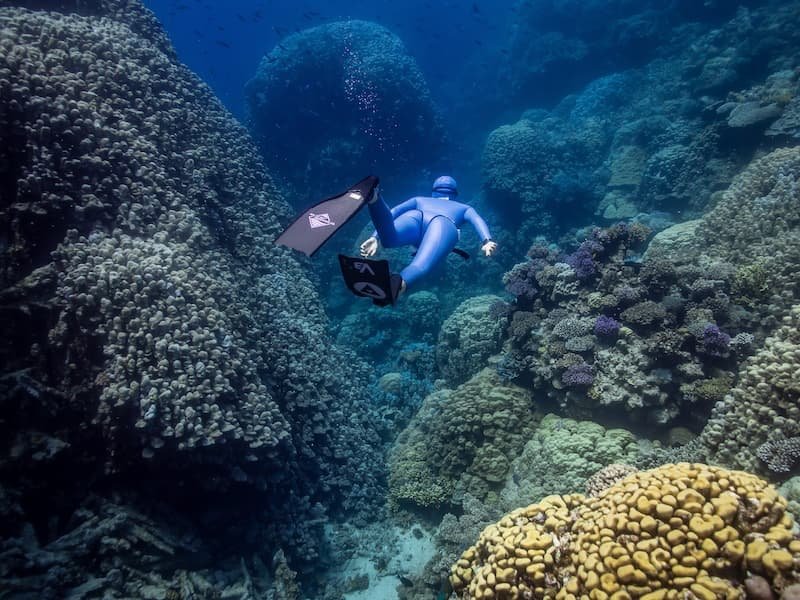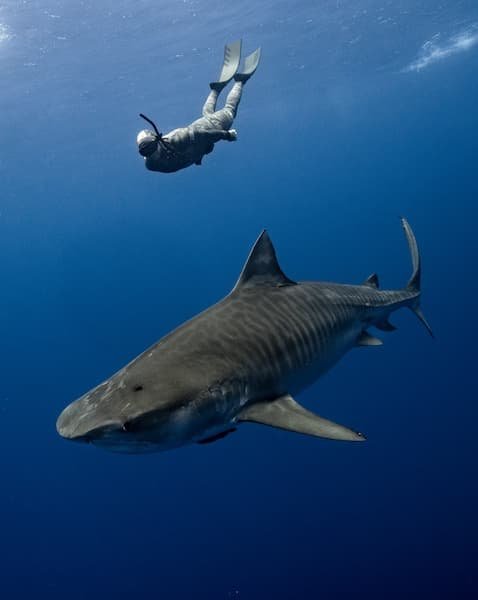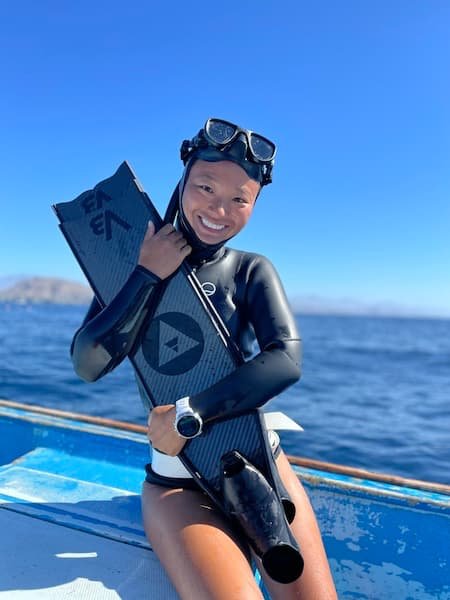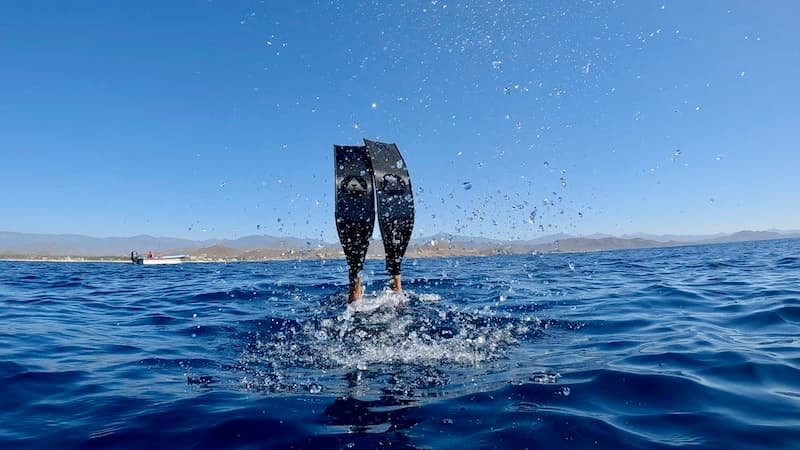
 Olivia Møller
Freediver - Activist - Explorer
Olivia Møller
Freediver - Activist - Explorer

 Olivia Møller
Freediver - Activist - Explorer
Olivia Møller
Freediver - Activist - Explorer
I never thought that the thing grounding my soul, the ocean with its vast blue quietude, could also be a source of guilt, ignorance, and missed potential. Freediving is marketed as the purest human-water interaction: minimal kit, maximum intimacy, zero noise. Yet here I am, paddling alongside my dive buddies, blissfully admiring corals, sea turtles, schools of fish... but without truly knowing them. We press for more depth, longer apnea, higher performance. And talk endlessly about fins, monofins, lanyards, and dive times. But who talks about the ocean’s lifeblood? I started asking myself: should marine ecology be a prerequisite for freediving certification?
The freediving community thrives on stories of extreme immersion. "I went down to 85 metres and saw no one." "Held my breath for 5-6 minutes." These tales celebrate endurance, inner calm, and the dance with pressure. But that same community often treats the underwater world as scenery, a thrilling backdrop for goggles-and-mask selfies, action videos, Instagram milestones. We’ve traded ethical depth for personal achievement. Any diver who entered certification processes will recognize the trend: marine ecology is a single lecture (if included), usually optional, and weighed like extra credit. What if it weren’t?
There is no question that freediving fosters respect. You can’t harass wildlife when you’re gasping for air. You learn silence, deliberate movement, and humility in the face of marine giants. But respect is hollow if it isn’t informed. Knowing how to equalize or control your heart rate at 20 metres doesn’t tell you which coral is bleaching, which fish species is endangered, or why that reef is losing diversity. Freediving is a teacher, but too often we refuse or defer the lesson of ecology.

Knowledge is not academic baggage. It’s the bridge from passive admiration to active stewardship. If divers recognize a threatened parrotfish or an invasive lionfish, they are more likely to change behavior: reduce contact, avoid anchoring, support reef restoration. Education catalyzes action. A Freediving Certification with Ecology (FCE), a certification requiring proficiency in marine ecosystems, would flip the script. It’s not about passing a quiz. It’s about grounding freediving in context. Imagine an exam that isn’t just "what is tidal shift," but "how does sedimentation affect seagrass growth and why does that matter?"
UNESCO, IUCN, and other bodies have declared marine ecosystems as nearing thresholds of collapse. Coral reefs have lost half their coverage in recent decades. Over 25 percent of marine species are threatened. Freedivers, who are in intimate dialogue with these waters, should shoulder some responsibility. We are not just tourists or thrill seekers. We are vulnerable witnesses. By requiring marine ecological literacy, freediving certifiers signal that the sport holds environmental stewardship as a core value, not a footnote.
Outdoor certifications already set bar sizes. Wilderness first responder training demands ecology modules. Surf instructor programs teach rip current dynamics and beach erosion. Scuba certifications (like PADI ReActivate or Project AWARE) offer optional ecology courses and market them as value-adds. Yet these remain optional, and the core remains gear driven, depth driven. Freediving can leapfrog by making ecology a requirement, not an afterthought.
It starts with three pillars:
1. Local Reef Ecology
- Identification of keystone species (e.g., parrotfish, sea cucumbers, cleaner wrasse) and their ecological roles
- Understanding reef structures: corals, sponges, seagrass beds, mangroves
- Taxonomy basics and age-based species recognition
2. Threat Assessment
- Human driven threats: overfishing (line vs. spear), sedimentation, plastic pollution
- Natural threats: climate driven coral bleaching; tropical storms; invasive species
- Local stressors: wastewater runoff (particularly in populated Mediterranean coasts like Greece)
3. Conservation & Stewardship Actions
- Behavior modification underwater and topside: avoiding fins on substrate, anchoring protocols
- Citizen science contributions: photo voucher surveys, species logs, data submission to platforms like iNaturalist or Reef Check
- Support models: partnering with local NGOs, donating to restoration, organizing beach clean ups
Certification would require a mix:
- In class or online theoretical test: this is open book, to focus on comprehension
- In water practical: for example, successfully identify five species, conduct a 5 minute reef survey
- Community contribution: a small scale post certification action plan, such as "I will lead one dive per quarter with an educational component for locals"

"We’re here to dive, not play scientist." Freediving already fosters mindfulness. Ecology doesn’t bury that. It amplifies it. It turns your bottom time from a personal record into a learning opportunity. And learning is empowerment. It’s the difference between "wow, that reef is beautiful" and "wow, that Acropora is bleached due to recent sea surface temperature rise, something I can help monitor."
"It adds cost and complexity to certification." Yes, but minimal. A single extra coursework (perhaps bundled with safety or navigation lessons) and a 30 minute quiz could suffice. Practical sections can piggyback onto existing dives. Administration cost is negligible. Compare this to the environmental cost of doing nothing. An extra 20 dollar fee is a bargain for an ecologically literate diver.
"Not all freedivers travel to biodiverse tropical reefs. What about Icelandic fjords?" Local context matters. A diver in northern Greece should learn Posidonia seagrass and local fish, whereas one in New Zealand learns kelp forest dynamics. But the underlying structure is universal: ecosystems, threats, and stewardship. Swap coral reefs for kelp forests or arctic sponge fields. The blueprint holds.
Freediving attracts charismatic, media savvy people. Social media loves freediving content. If freediving certifications carried an ecology badge, those ambassadors broadcast not just breathtaking images but ecological narratives. Instagram captions could carry species facts. Video content could annotate reef condition or pollution metrics. It shifts the narrative from personal triumph to collective responsibility.
When freediving schools root ecology in certifications, local operators can regain maritime heritage. In Greece, younger divers learn the Kalymnian sponge divers’ traditions and the historical symbiosis between humans and the sea. Ecology training reclaims rootedness from the rampant tourism narrative. You’re not just a fleet of fins but a community protector.
Widespread environmental literacy could translate to policy advocacy. As certified freedivers flood social media with reef footage and ecology insights, policymakers pay attention. Insurance companies might even offer reduced liability if freedivers complete environmental modules. NGOs see value and channel funding to community-led reef monitoring programs.

1. Define curriculum guidelines: Freediving certifying bodies (AIDA, PADI, SSI, Molchanovs) collaborate with marine biologists and NGOs to outline a universal module adaptable globally.
2. Pilot program: Launch annual pilot in 5 to 10 freediving hubs: Mediterranean, Caribbean, Pacific Islands, Baltic Sea. Evaluate outcomes: quiz pass rates, post dive surveys, follow up stewardship actions.
3. Toolkits for instructors: Provide slide decks, species ID cards, citizen science templates, online communities for sharing findings.
4. Certification integration: Embed into existing certification tracks. Remove optionality. Successful completion results in dual recognition: freediver and environmental literate diver.
5. Incentives and sustainability: Offer schools tax or marketing incentives. Promote use of the ecology stamp as a brand differentiator.
6. Long term evaluation: Track changes in diver behavior, reef conditions around partner schools, social media engagement, local policy shifts. Publish annual Freediving Ecology Impact Report.

What about freediving schools in remote, equipment-limited areas? The required mapping is minimal: no fancy microscopes, just posters and tablets showing local marine life. Practical exams can be logic driven (for example, here's an image, name it) or done in water with species sightings. Schools already record sightings for guides. This just makes it formal. And yes, translation to dozens of languages is needed: Greek, Spanish, Hindi, Japanese. The freediving community itself is global. It can produce localized content.
Freediving prides itself on purity: no air tanks, no noise, just human and water. But if we want to claim that purity, let’s align it with ecological clean handedness. Freediving’s next evolutionary step is to know what we’re touching with our fins, not just how far we can hold our breath. We need freedivers who whisper in scientific shorthand: "That’s Xestospongia muta, and its decline signals warming upwellings." And freedivers who feel equally skilled in plankton ID as in vessel chase protocol.
So called elite freedivers, icons, the media figureheads, should rise up as ecological ambassadors, exporting the message: certification is dual axis. Depth and awareness. Breath and biology. Performance and protection. Freediving without ecological literacy is like climbing Everest without knowing the melt of the glacier under your crampons.